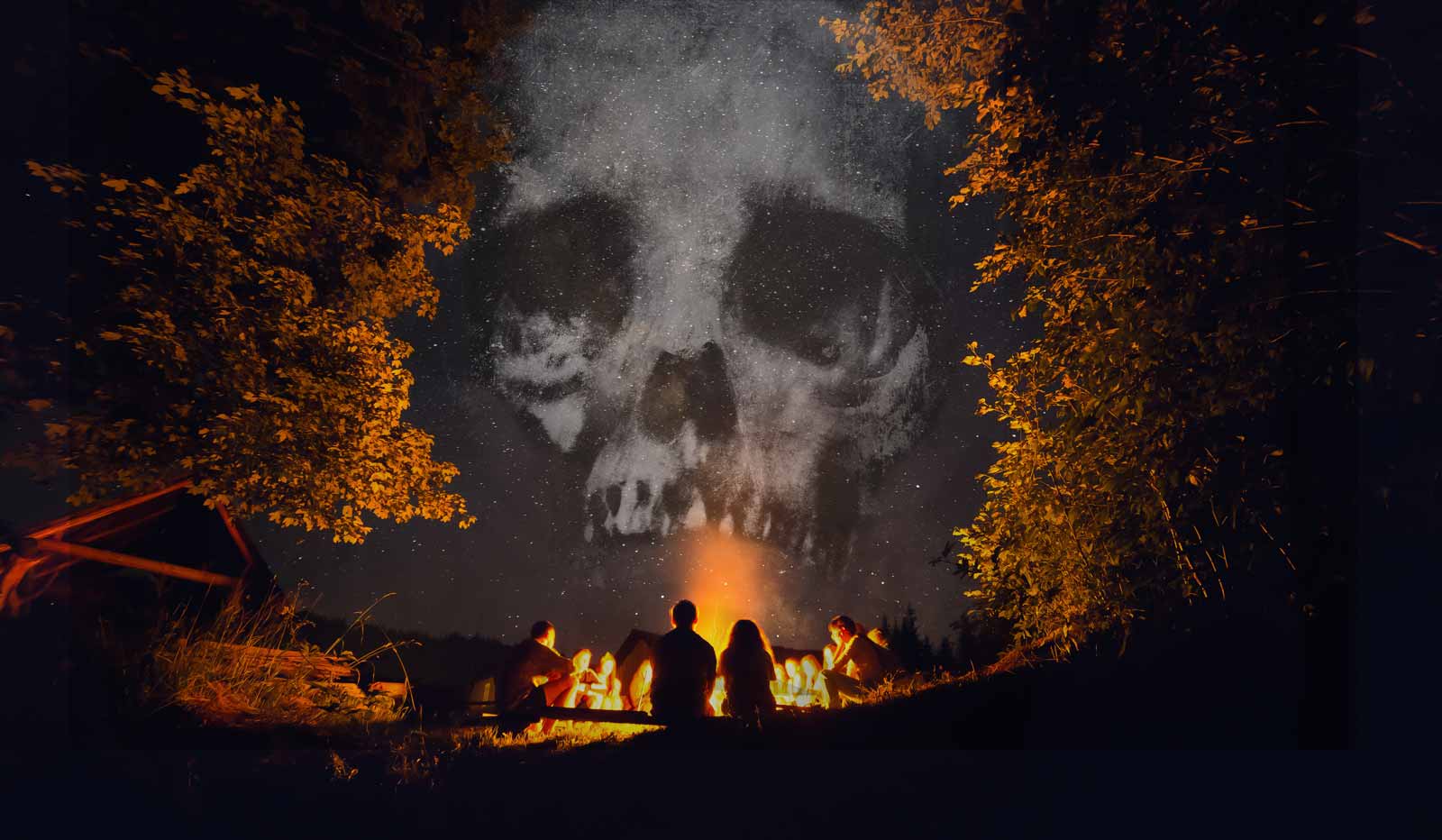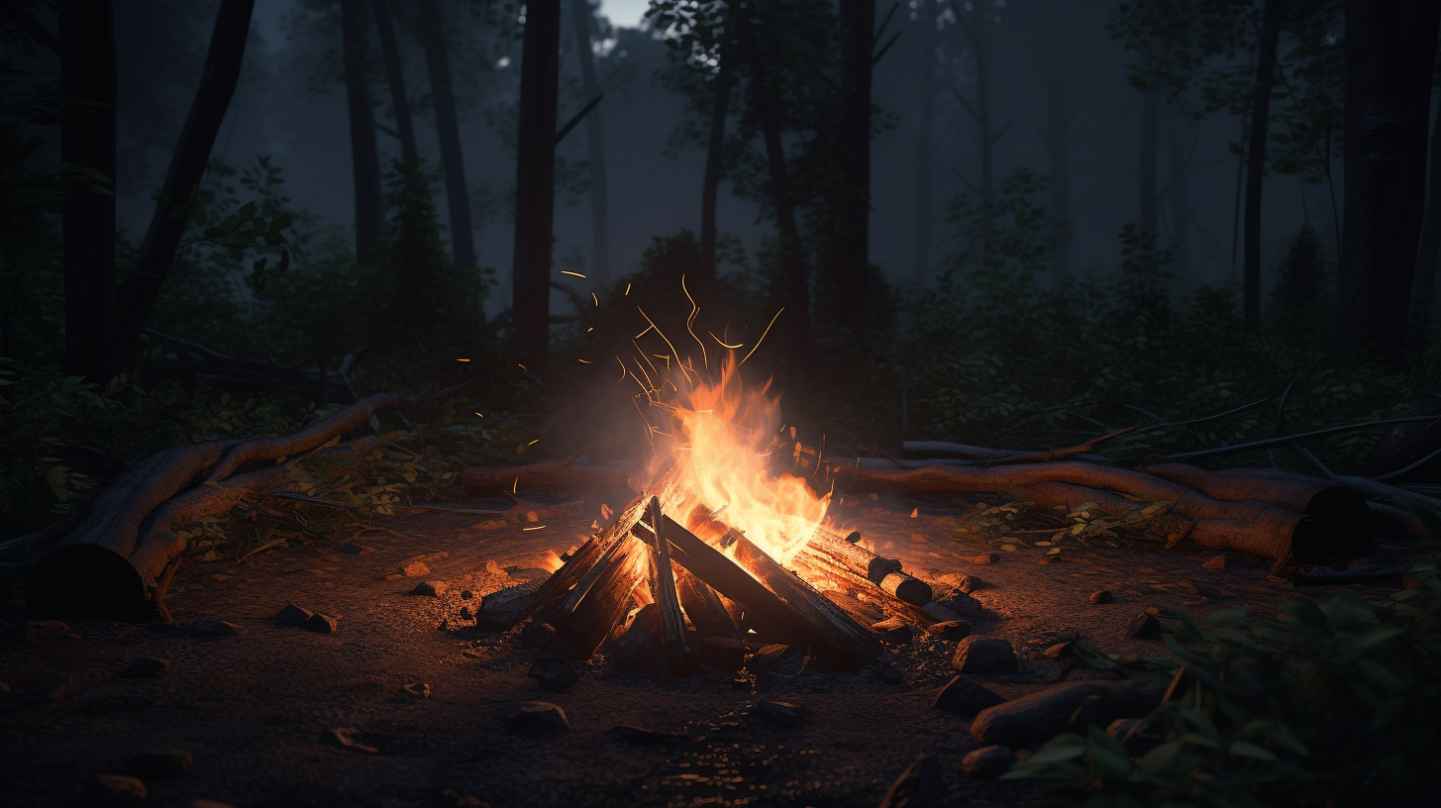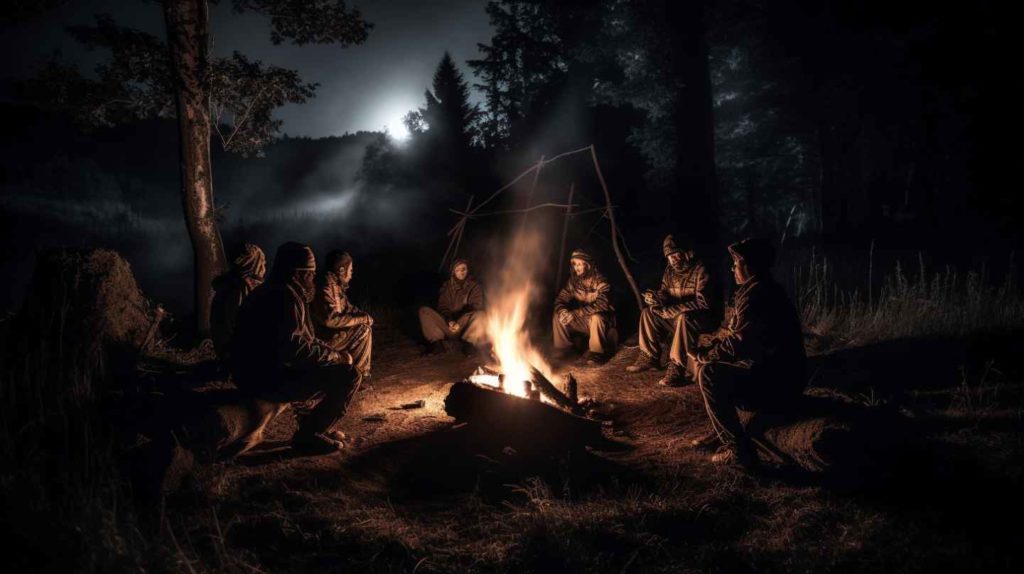Welcome to the mesmerizing world of campfire stories, where flickering flames cast dancing shadows and spine-tingling tales are spun amid the enchanting ambiance of the great outdoors. There is a primal allure and an age-old tradition surrounding the sharing of campfire stories, captivating listeners with hair-raising narratives that send shivers down their spines.
From generations past to the present day, the flickering flames and crackling wood have provided the perfect backdrop for storytellers to weave their magic. The allure of campfire stories lies in their ability to evoke a wide range of emotions, from peals of nervous laughter to fearful anticipation. The darkened night sky, the creaking of trees, and the rustling leaves create an atmosphere that heightens the senses as the tales unfold.
Within the fabric of these stories, the spine-tingling essence takes hold. You’ll be drawn into haunted encounters in the wilderness, where disembodied whispers seem to echo through the trees. You’ll feel your heart race as survival tales recount harrowing experiences in the face of nature’s wrath. And the blood will freeze in your veins as you listen to urban legends that blur the lines between reality and myth, haunting our collective imaginations.
So gather around the proverbial campfire, dear reader, as we embark on a journey through the most bone-chilling and captivating campfire stories. Brace yourself for the inexplicable, the uncanny, and the eerie as we explore the art of storytelling that continues to captivate and enchant outdoor enthusiasts of all ages.

The Power of a Thrilling Narrative
Campfire stories have an uncanny ability to captivate and enthrall us, leaving us on the edge of our seats. But have you ever wondered why we are so drawn to these spine-tingling tales? It all boils down to the power of a thrilling narrative and its profound impact on our psyche.
Understanding the Psychology
As humans, we possess an innate fascination with the unknown and the mysterious. Scary stories tap into that curiosity, allowing us to explore a darker side of our imagination. When we engage with these narratives, we willingly subject ourselves to a rollercoaster of emotions, ranging from fear and anxiety to excitement and anticipation.
The thrill and adrenaline rush associated with being scared are at the core of our attraction to spine-tingling tales. It’s a primal response that can be traced back to our ancestors, who relied on fear as a survival mechanism. Even though we no longer face the same life-or-death situations, the adrenaline surge created by a well-told scary story still activates our fight-or-flight response.
But what truly sets campfire stories apart is their ability to build suspense and anticipation. Skilled storytellers know how to gradually escalate tension, creating a palpable sense of unease in their listeners. Each twist and turn in the narrative takes us deeper into the unknown, heightening the adrenaline and leaving us craving for more.
Evolution of Campfire Stories
The tradition of sharing stories around a campfire stretches back through the annals of time, woven intricately into the fabric of human culture. From ancient civilizations to modern-day camping trips, the practice has endured across centuries and continents.
In the early days of humanity, storytelling served a vital purpose beyond mere entertainment. It was a way to pass down knowledge, legends, and cautionary tales from one generation to the next. Campfire stories became a means of imparting wisdom, teaching survival skills, and instilling a sense of shared identity within communities.
Over time, as societies evolved and technology advanced, campfire stories adapted to the changing landscape. They continued to offer a valuable escape from the confines of daily life, providing an opportunity to connect with others on a deeper level. The essence of campfire storytelling remained intact, even as stories now spanned from ancient folklore to modern urban legends.
Classic Campfire Story Themes
When it comes to campfire storytelling, some themes have stood the test of time, captivating listeners and sending shivers down their spines. Let’s explore three classic campfire story themes that never fail to evoke a sense of mystery and excitement.

A. Haunted Encounters in the Wilderness
There’s something undeniably eerie about the wilderness at night. Haunted forests, abandoned cabins, and mysterious trails have long been the settings for spine-chilling tales. These stories often involve encounters with the supernatural, ghosts, apparitions, or inexplicable phenomena that send chills down your spine.
One particularly famous legend revolves around the haunted forest of Blackwood. Locals claim that anyone who dares venture into its depths risks encountering the ghostly apparition of a lost hiker. The tale has been passed down through generations, making it a staple of campfire storytelling in the surrounding area.
Not all stories, however, are mere urban legends. There have been documented instances of spine-chilling encounters that have become the stuff of campfire lore. Take the case of the Mysterious Watcher, a real-life tale that has intrigued outdoor enthusiasts for years. Hikers in a remote mountain range reported being pursued by an unseen entity, always catching glimpses of a figure lurking just at the edge of their vision. These real-world accounts add an extra layer of fear and fascination to the campfire narrative.
B. Terrifying Tales of Survival
The great outdoors can be both awe-inspiring and unforgiving, and survival stories gone wrong make for gripping campfire tales. These narratives often depict harrowing encounters with dangerous wildlife, unexpected natural disasters, or the sheer unpredictability of Mother Nature.
Imagine finding yourself camping deep in the backcountry when suddenly a powerful storm unleashes its fury. Lightning cracks through the sky, rain pours, and winds howl. Such circumstances can quickly escalate into life-threatening situations as campers struggle to find shelter, brace against the elements, and survive against all odds.
Animal encounters are another source of spine-tingling survival stories. One particularly gripping tale tells of a group of hikers who mistakenly stumbled upon a bear’s territory. As their panicked hearts raced, they had to rely on their wits and knowledge of bear behavior to escape the creature’s wrath.
C. Urban Legends to Make Your Skin Crawl
Urban legends have become synonymous with campfire storytelling, enthralling listeners with their chilling narratives that blur the line between fact and fiction.
One such legend is that of the Hook Man. This spine-chilling tale spins a yarn of a couple parked at a secluded spot in the woods when they hear a news bulletin warning of an escaped mental patient with a hook for a hand. As they become increasingly frightened, an eerie scraping sound is heard on the car roof, leading them to a shocking discovery.
Another legendary tale that never fails to send shivers down the spine is that of the Vanishing Hitchhiker. This haunting story recounts encounters with a ghostly hitchhiker who mysteriously vanishes from the car during the journey, leaving a trail of unanswered questions in their wake.
These urban legends have persisted over time, evolving with each retelling and captivating new audiences with their ability to invoke fear and anticipation. They have become an integral part of campfire storytelling, ensuring that listeners will continue to feel their skin crawl long after the fire has died down.
Techniques for Crafting Spine-Tingling Stories
Crafting a truly spine-tingling campfire story requires a skillful combination of elements that build suspense and tension, keeping your audience on the edge of their seats. In this section, we will explore some techniques that can help you create an atmosphere of fear and anticipation that will leave your listeners captivated.
A. Building Suspense and Tension
To create a suspenseful atmosphere, consider the following tips:
1. Setting the Stage: Choose a dark and secluded location, ideally with only the flickering light of the campfire illuminating faces. This ambiance enhances the sense of mystery and vulnerability.
2. Pacing: Vary the rhythm of your storytelling, alternating between moments of calm and intense excitement. Slow down during crucial moments to build anticipation, and then deliver impactful revelations or twists.
3. Foreshadowing: Hints and suggestions of imminent danger can intensify the sense of foreboding. Drop subtle clues or eerie details throughout your story, leaving your audience with an unsettling feeling.
4. Dial Up the Details: Incorporate specific and vivid descriptions of the surroundings, characters, and events to immerse your listeners in the narrative. Engaging multiple senses by describing sights, sounds, smells, and textures can heighten the overall impact.
Consider these techniques used in well-known campfire tales such as “The Hook” or “The Legend of Sleepy Hollow” to understand how effective storytelling builds suspense.
B. Utilizing Vivid Descriptions and Imagery
When it comes to spine-tingling stories, descriptive language and imagery play crucial roles in immersing listeners in the narrative. Here are some key considerations:
1. The Power of Imagery: Paint vivid mental pictures by using evocative imagery. Describe the eerie moonlit forest, the bone-chilling wind that whistles through the trees, or the palpable tension in the air. Engaging the senses allows the audience to experience the story more intensely.
2. Harness Fear-Inducing Senses: Tap into primal fears by focusing on sensory details that evoke fear. A creaking floorboard, distant whispers in the dark, or the sensation of being watched can intensify the suspense and send shivers down your listeners’ spines.
3. Create Characters that Resonate: Develop characters your audience can relate to or invest in emotionally. By establishing a connection, their fears and vulnerabilities become more palpable. Make your listeners care about the characters’ fate, increasing the story’s impact.
By incorporating these techniques into your stories, you can transport your listeners into a world of spine-tingling suspense, leaving them captivated and eager for more.
The Art of Storytelling: Tips and Tricks
When it comes to sharing campfire stories that will send chills down your spine, the way you tell the story is just as important as the story itself. Mastering the art of storytelling can elevate the entire campfire experience, leaving your listeners on the edge of their seats.
Here are some valuable tips and tricks to help you become a captivating storyteller around the flickering flames:
- Voice Modulation: Utilize the power of your voice to create an immersive experience. Vary your tone, pitch, and volume to match the emotions you want to evoke in the audience. Lower your voice for suspenseful moments and raise it for moments of intensity. This dynamic use of voice modulation can intensify the overall impact of your story.
- Pacing and Timing: Pay attention to the rhythm and speed at which you narrate the story. Slow down during climactic moments to build anticipation, and speed up during action-packed sequences. By adjusting the pacing and timing, you can effectively control the ebb and flow of tension within your storytelling.
- Interactive Elements: Engage your listeners by incorporating interactive elements into your storytelling. Consider adding sound effects to create a more immersive ambiance. For example, rustling leaves, crackling fire, or distant howling can enhance the atmosphere and increase the sense of realism. Additionally, embrace audience participation by encouraging them to contribute to the story, such as echoing certain phrases or joining in on suspenseful pauses. This level of interaction will make the experience even more memorable for everyone involved.
Remember, campfire storytelling is a shared experience that fosters a sense of community. Encourage your audience to participate and share their own spine-tingling campfire stories. Let them create an atmosphere of eerie excitement by contributing their unique tales of the outdoors. Whether it’s through the comments section of your article or on social media platforms, extending the conversation beyond the campfire will keep the spirit of storytelling alive long after the flames have died down.
Conclusion: Embrace the Shivers
As we reach the end of our journey through spine-tingling campfire stories, it’s important to recap the thrill and enjoyment that comes with sharing these captivating tales. The age-old tradition of gathering around a crackling fire and immersing ourselves in narratives that send chills down our spines holds a special place in our hearts.
So, dear readers, as you navigate the wilderness or plan your next camping adventure, we encourage you to gather around the campfire, surrounded by the enchanting sounds of nature. Embrace the darkness that surrounds you and allow yourself to be embraced by the shivers and suspense that only a well-crafted spine-tingling story can evoke.
Remember, campfire stories are not merely tales but a reflection of our primal human instincts. They serve as reminders of our vulnerability in the face of nature’s mysterious forces and the enduring testament of our resilience. Whether you are a seasoned storyteller or a curious listener, these narratives bridge generations, connect us with our past, and ignite our imagination.
So, gather your friends and loved ones, stoke the flames of the campfire, and prepare yourselves for an unforgettable experience. Get ready to pass down the age-old tradition of spine-tingling campfire storytelling and create memories that will continue to resonate for years to come.
FAQs
1. Why are humans drawn to scary stories?
Humans are drawn to scary stories because they provide a thrilling experience and tap into our innate love for the adrenaline rush associated with fear. The suspense and anticipation built within these stories captivate us and awaken our primal instincts.
2. How have campfire stories evolved over time?
Campfire stories have evolved over time to adapt to modern settings while retaining their core elements of suspense and fear. With advancements in technology, stories now incorporate urban legends and modern-day horrors alongside traditional tales of haunted forests and wilderness encounters.
3. What are some classic campfire story themes?
Classic campfire story themes include haunted encounters in the wilderness, terrifying tales of survival, and popular urban legends. These themes are designed to give listeners a spine-tingling experience and leave them with a sense of lingering fear.
4. How can I create suspense and tension in my own campfire stories?
You can create suspense and tension in your campfire stories by carefully crafting the setting, pacing, and foreshadowing. Building anticipation through well-placed details and cliffhangers can keep your audience on the edge of their seats.
5. What techniques can I use to make my campfire stories more vivid and captivating?
To make your campfire stories more vivid and captivating, utilize vivid descriptions and imagery that appeal to your listeners’ senses. Engage their imagination with sensory details, such as the sound of cracking twigs or the scent of damp earth, to immerse them in the story.

